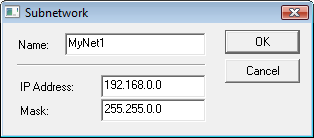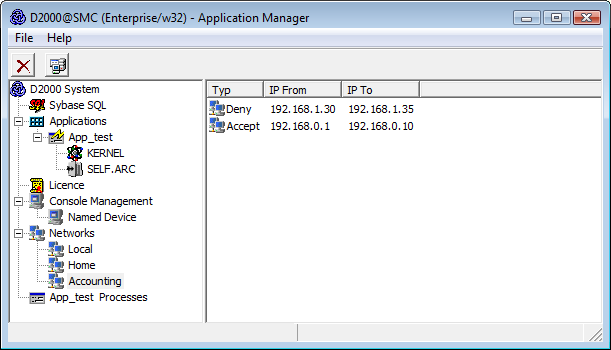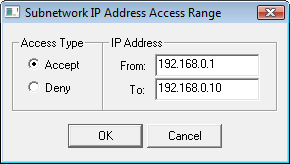D2000 processes can communicate with a D2000 Server process in two ways:
- via shared memory (e.g. processes running on the same computer as the
Procesy systému D2000 môžu komunikovať s procesom D2000 Server dvoma spôsobmi:
- cez zdieľanú pamäť (t.j. procesy bežiace na rovnakom počítači ako D2000 Server)
- prostredníctvom through TCP/IP alebo or Dual TCP/IP komunikácie
Pre procesy komunikujúce druhým spôsobom, proces D2000 Application Manager umožňuje povoliť prihlasovanie klientov len zo špecifických IP adries. V súčasnej verzii systému D2000 je možné definovať maximálne 10 sietí.
...
Sieť je definovaná svojím menom, IP adresou a maskou. Na definovanie siete slúži nasledovné dialógové okno, ktoré sa zobrazí po výbere položky New SubNetwork z miestnej ponuky otvorenej stlačením pravého tlačidla myši nad položkou Networks.
...
V samotnej sieti je možné definovať niekoľko tzv. rozsahov prístupu, t.j. povolenie alebo zamietnutie určitých IP adries počítačov v tejto sieti.
...
Rozsah sa definuje v nasledovnom dialógu, ktorý sa otvorí po výbere položky New IP Access Range z miestnej ponuky otvorenej stlačením pravého tlačidla myši nad danou sieťou.
...
Proces D2000 Server teda kontroluje IP adresy klientov (procesov), ktorí sa k nemu pripájajú pomocou TCP/IP alebo Dual TCP/IP komunikácie nasledovne:
- communication
For processes communicating in the other way, the D2000 Application Manager process enables you to allow clients to log in only from specific IP addresses. In the current version of the D2000 system, a maximum of 10 networks can be defined.
The network is defined by its name, IP address and mask. To define a network, use the following dialog box, which appears when you select New SubNetwork from the context menu that is open by right-clicking on Networks.
In the network itself, it is possible to define several so-called access ranges, i.e allow or deny certain IP addresses of computers on this network.
The range is defined in the following dialog, which opens after selecting New IP Access Range from the context menu opened by right-clicking on the network.
The D2000 Server process, therefore, checks the IP addresses of the clients (processes) that connect to it using TCP / IP or Dual TCP / IP communication as follows:
- if no network is configured, IP address checking is not performed,
- if at least one network is configured, the client is checked to see if it belongs to one of the defined networks:
- if the client does not belong, the connection will be rejected,
- if the client belongs, then it is further checked that all the networks to which they belong meet one of the following conditions:
- no ranges are defined in the network
- at least one Accept type range is defined in the network, to which the client's IP address belongs and there is no Deny type range to which the client's IP address belongs
The client will be connected if at least one of the above conditions is valid. Otherwise, the connection will be rejected and the message
- pokiaľ nie je nakonfigurovaná žiadna sieť, kontrola IP adries sa nevykonáva,
- ak je nakonfigurovaná aspoň jedna sieť, vykoná sa kontrola klienta, či patrí do niektorej z definovaných sietí:
- ak nepatrí, spojenie bude odmietnuté,
- ak patrí, potom sa ďalej kontroluje, či všetky siete, do ktorých patrí, spĺňajú jednu z nasledovných podmienok:
- v sieti nie sú definované žiadne rozsahy
- v sieti je definovaný aspoň jeden rozsah typu Accept, do ktorého IP adresa klienta patrí a neexistuje žiaden rozsah typu Deny, do ktorého IP adresa klienta patrí
UPOZORNENIE
- Definovanie alebo editácia sietí a rozsahov je povolená len pri bežiacom procese D2000 Server.
- Pri redundancii aplikačného servera je definovanie a editácia povolená len pre HOT Server, t.j. proces D2000 Server, ktorý je v stave HOT (HS). Po ukončení editácie sú všetky zmeny zaslané z HOT Servera do STANDBY Servera.
WARNING
- Defining or editing networks and ranges is only allowed while the D2000 Server process is running.
- When the application server is redundant, definition and editing are allowed only for the HOT Server, that being a D2000 Server process in the HOT (HS) state. After editing, all changes are sent from the HOT Server to the STANDBY Server.
ExamplePríklad:
| SubNetwork | IP Address | Mask | Range |
|---|
| Possible connection | ||
|---|---|---|
| Local | 127.0.0.1 | 255.255.255.255 |
| none |
| local clients | ||
| Production | 192.168.0.0 | 255.255.255.0 |
| none | clients with 192.168.0.1 |
| through 254 IP addresses | ||||||||||||
| Accounting | 192.168.1.0 | 255.255.255.0 |
|
| clients with 192.168.1.1 |
| through 100 IP addresses, except IP addresses - 192.168.1.30 |
| up until 35 | ||
| Director_Home | 195.10.0.22 | 255.255.255.255 |
| none | a client with 195.10.0. |
| 22 IP address |
Poznámka Note 1:
Proces By default, the D2000 Application Manager process connects to the D2000 Server
process over sa štandardne pripája k procesu D2000 Server cez TCP/IP. Preto pred konfigurovaním sietí pomocou procesu D2000 Application Manager je potrebné pridať sieť s IP adresou Hence, before configuring networks using the D2000 Application Manager process, it is necessary to add a network with 127.0.0.1 a maskou 1 IP address and the mask 255.255.255.255. Ak táto sieť nie je nakonfigurovaná, proces D2000 Application Manager sa po vypnutí a zapnutí nepripojí k procesu D2000 Server (zobrazí sa chybové hlásenie If this network is not configured, the D2000 Application Manager process will not connect to the D2000 Server process after turning it off and on (the error message PROCES_TCPIP_DENY is displayed). V tomto prípade je možné proces D2000 Application Manager spustiť len pomocou štartovacieho parametra /M, pomocou ktorého sa pripojí k procesu D2000 Server prostredníctvom zdieľanej pamäte.
Poznámka 2:
Postup uvedený v poznámke 1 nie je funkčný v prostredí Windows Terminal Services. Tam odporúčame jednu z nasledovných alternatív:
In this case, the D2000 Application Manager process can only be started with the /M startup parameter, which connects to the D2000 Server process via shared memory.
Note 2:
The procedure in Note 1 does not work in a Windows Terminal Services environment. There we recommend one of the following alternatives:
- connect to the console pripojiť sa ku konzolovej session (mstsc.exe/console) a spustiť proces and run the D2000 Application Manager s parametrom process with the /M parameter
- manually modify the ConsolesInfo.txt file located in the D2000 program directory - delete the [SUBNET] and [IPACCESS] sections and either restart the D2000 Server process or use the TELL REFRESH_LICENCE command. ručne modifikovať súbor ConsolesInfo.txt nachádzajúci sa v programovom adresári systému D2000 - vymazať sekcie [SUBNET] a [IPACCESS] a buď reštartovať proces D2000 Server, alebo použiť TELL príkaz REFRESH_LICENCE.



